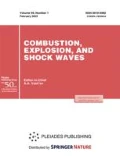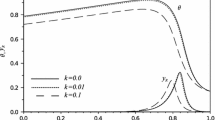Abstract
Data on the most important combustion and detonation parameters, such as wave velocities, pressures and temperatures of products, specific energy release of mixtures are presented for saturated hydrocarbons C\(_{n}\)H\(_{2n + 2 }\) [from methane (\(n\) = 1) to eicosane (\(n\) = 20)] and unsaturated hydrocarbons C\(_{n}\)H\(_{2n}\)[from ethylene (\(n\) = 2) to eicosene (\(n\) = 20)], also methanol and ethanol as the main components of biofuel and monofuels as a source of bifurcation structures of multifront detonation. Data are also given on the critical initiation energies as a measure of the explosion hazard of combustible systems: the lower the energy, the more hazardous the mixture. Data were obtained for mixtures of each individual hydrocarbon with oxygen and air in a wide range of initial parameters: pressure, temperature, concentration and phase state of fuel components.







Similar content being viewed by others
REFERENCES
L. V. Gurvich, G. A. Khachkuruzov, V. F. Medvedev, et al.,Thermodynamic Properties of Individual Substances: Handbook, Ed. by V. P. Glushko (Izd. Akad. Nauk, Moscow, 1962) [in Russian].
Thermodynamic Properties of Individual Substances: Reference Book, Ed. by V. P. Glushko (Nauka, 1979), Vols. I–II [in Russian].
V. E. Alemasov, A. F. Dregalin, A. P. Tishin, and V. A. Khudyakov, ıThermodynamic and Thermophysical Properties of Combustion Products: Reference Book, Vol. I: Methods of Calculation, Ed. by V. P. Glushko (VINITI, Moscow, 1971) [in Russian].
Thermodynamic and Thermophysical Properties of Combustion Products: Reference Book (VINITI, Moscow, 1971) [in Russian].
M. P. Vukalovich, V. A. Kirillin, and S. A. Remizov,Thermodynamic Properties of Gases (Mashgiz, Moscow, 1953) [in Russian].
D. R. Stall, E. F. Westrum, and G. S. Zinke, The Chemical Thermodynamics of Organic Compounds (Wiley, New York, 1969).
V. A. Kireev, Methods of Practical Calculations in the Thermodynamics of Chemical Reactions (Khimiya, Moscow, 1970) [in Russian].
C. K. Westbrook and P. A. Urtiew, “Use of Chemical Kinetics to Predict Critical Parameters of Gaseous Detonation," Fiz. Goreniya Vzryva 19 (6), 65–76 (1983) [Combust., Expl., Shock Waves19 (6), 753–766 (1983).
V. M. Zamanskii and A. A. Borisov, “Mechanism and Promotion of Self-Ignition of Promising Fuels," in Results of Science and Engineering, Ser. Kinet. Katal. (VINITI, Moscow, 1989) [in Russian].
V. M. Zamansky and A. A. Borisov, “Promotion of High-Temperature Self-Ignition," Prog. Energy Combust. Sci. 18, 297–325 (1992).
V. I. Babushok and A. N. Dakdancha, “Global Kinetic Parameters for High-Temperature Gas-Phase Reactions," Fiz. Goreniya Vzryva29 (4), 48–80 (1993) [Combust., Expl., Shock Waves29 (4), 464–489 (1993)].
J. Warnatz, U. Maas, and R. W. Dibble, Combustion: Physical and Chemical Fundamentals, Modeling and Simulation, Experiments, Pollutant Formation (Springer-Verlag, Berlin, 2000).
A. A. Vasil’ev, et al., “Correctness of Kinetic Data for Prediction of Multifront Detonation: Effect of Nitrogen," in Proc. of the 21st ICDERS, CD (Poitiers, France, 2007).
A. A. Vasil’ev, “Ignition Delay in Multi-Fuel Mixtures," Fiz. Goreniya Vzryva 43 (3), 42–46 (2007) [Combust., Expl., Shock Waves 43 (3), 282–285 (2007)].
A. A. Vasil’ev, “Reliability of Kinetic Data Used for Estimating Multifront Detonation Parameters," Fiz. Goreniya Vzryva45 (3), 89–94 (2009) [Combust., Expl., Shock Waves45 (3), 314–319 (2009).
Anatoly A. Vasil’ev, “Dynamic Parameters of Detonation,"Shock Wave Science and Technology Reference Library, Vol. 6: Detonation Dynamics Ed. by F. Zhang (Springer, 2012).
A. A. Vasil’ev, “Detonation Hazards of Gaseous Mixtures," inPrevention of Hazardous Fires and Explosions. The Transfer to Civil Applications of Military Experiences, Ed. by V. E. Zarko et. al. (Kluwer, Dordrecht–Boston–London, 1999), pp. 93–108.
A. A. Vasil’ev,, A. I. Valishev, V. A. Vasil’ev, L. V. Panfilova, and M. E. Topchian, “Hydrogen Accidents and Their Hazard," inPrevention of Hazardous Fires and Explosions. The Transfer to Civil Applications of Military Experiences, Ed. by V. E. Zarko, V. Weiser, N. Eisenreich, and A. A. Vasil’ev (Kluwer, Dordrecht–Boston–London, 1999), pp. 151–165.
A. A. Vasil’ev, A. A. Valishev, V. A. Vasil’ev, and L. V. Panfilova, “Combustion and Detonation Characteristics of Hydrazine and Its Methyl Derivatives," Fiz. Goreniya Vzryva36 (3), 81–96 (2000) [Combust., Expl., Shock Waves36 (3), 358–373 (2000)].
A. A. Vasil’ev, “Detonation Properties of the Synthesis Gas," Fiz. Goreniya Vzryva 43 (6), 90–96 (2007) [Combust. Expl. Shock Waves 43 (6), 703–709 (2007)].
A. A. Vasil’ev, “Energy Aspects of Initiation of Domestic Gases," Fiz. Goreniya Vzryva 44 (1), 96–101 (2008) [Combust. Expl. Shock Waves 44(1), 86–91 (2008)].
A. A. Vasil’ev, “Detonation Properties of Saturated Hydrocarbons," Fiz. Goreniya Vzryva 45 (6), 82–90 (2009) [Combust., Expl., Shock Waves 45 (6), 708–716 (2009)].
A. A. Vasil’ev, V. A. Vasil’ev, and A. V. Trotsyuk, “Bifurcation Structures in Gas Detonation," Fiz. Goreniya Vzryva46 (2), 88–100 (2010) [Combust., Expl., Shock Waves46 (2), 196–206 (2010)].
A. A. Vasil’ev, V. A. Vasil’ev, “Hazards of Hydrogen and Synthetic Gas," in Explosion Dynamics and Hazards, Ed. by S. M. Frolov, F. Zhang, and P. Wolanski (Torus Press, Moscow, 2010).
A. A. Vasil’ev, “Monofuel As a Source of Bifurcation Properties of Multifuel Systems," Fiz. Goreniya Vzryva 50 (2), 14–23 (2014) [Combust., Expl., Shock Waves 50 (2), 135–143 (2014)].
A. A. Vasil’ev, “Cellular Structures of a Multifront Detonation Wave and Initiation (Review)," Fiz. Goreniya Vzryva51 (1), 9–30 (2015) [Combust., Expl., Shock Waves51 (1), 1–20 (2015)].
A. A. Vasil’ev and V. A. Vasil’ev, “Initiation of Multifuel Mixtures with Bifurcation Structures," Fiz. Goreniya Vzryva52 (6), 3–12 (2016) [Combust., Expl., Shock Waves52 (6), 621–630 (2016)].
Ya. B. Zel’dovich, S. M. Kogarko, and N. N. Simonov, “Experimental Study of Spherical Gas Detonation," Zh. Tekh. Fiz.26 (8), 1744–1768 (1956).
S. M. Kogarko, V. V. Adushkin, and A. G. Lyamin, “Investigation of Spherical Detonation of Gas Mixtures," Fiz. Goreniya Vzryva1 (2), 22–34 (1965) [Combust., Expl., Shock Waves1 (2), 15–22 (1965)].
R. A. Strehlow and C. D. Engel, “Transverse Waves in Detonation: II. Structure and Spacings in H2–O2, C2H2–O2, C2H4–O2 and CH4–O2 Systems," AIAA J. 7(3), 492–496 (1969).
D. H. Edwards, G. Hooper, and J. M. Morgan, “An Experimental Investigation of the Direct Initiation of Spherical Detonation," Acta Astronaut. 3 (1/2), 117–130 (1976).
H. Matsui and J. H. Lee, “On the Measure of the Relative Detonation Hazards of Gaseous Fuel–Oxygen and Air Mixtures," Symp. (Int.) Combust. 17 (1), 1269–1280 (1979).
D. C. Bull, I. E. Elsworth, and G. Hooper, “Initiation of Spherical Detonation in Hydrocarbon–Air Mixtures," Acta Astronaut.5 (11), 997–1008 (1978).
S. B. Murray, J. J. Gottlieb, C. Coffey, I. O. Moen, J. H. Lee, and D. Remboutsikas, “Direct Initiation of Detonation in Unconfined Ethylene–Air Mixtures—Influence of Bag Size," in 7th Symp. Mil. App. Blast Sim., 6.3(b)(1–28) (1982).
I. O. Moen, M. Donato, R. Knystautas, and J. H. Lee, “The Influence of Confinement on the Propagation of Detonations near the Detonability Limits," Symp. (Int.) Combust. 18 (1), 1615–1622 (1981).
D. C. Bull, “Towards an Understanding of the Detonability of Vapour Clouds," in Fuel–Air Explosions: Proc. Int. Conf., Ed. by J. H. S. Lee, and C. M. Guirao (Univ. of Waterloo Press, 1982).
D. C. Bull, J. E. Elsworth, P. J. Shuff, and E. Metcalfe, “Detonation Cell Structures in Fuel/Air Mixtures," Combust. Flame45 (1), 7–22 (1982).
I. O. Moen, S. B. Murray, D. Bjerketvedt, A. Rinnan, R. Knystautas, and J. H. Lee, “Diffraction of Detonation from Tubes into a Large Fuel–Air Explosive Cloud," Symp. (Int.) Combust. 19(1), 635–644 (1982).
R. Knystautas, J. H. Lee, and C. M. Guirao, “The Critical Tube Diameter for Detonation Failure in Hydrocarbon–Air Mixtures," Combust. Flame 48, 63–83 (1982).
J. H. Lee, R. Knystautas, and C. Guirao, “The Link between Cell Size, Critical Tube Diameter, Initiation Energy and Detonability Limits," in Fuel–Air Explosions: Proc. Int. Conf., Ed. by J. H. S. Lee, and C. M. Guirao (Univ. of Waterloo Press, 1982).
W. B. Benedick, “Review of Large Scale Fuel-Air Explosion Tests and Techniques," in Fuel–Air Explosions: Proc. Int. Conf., Ed. by J. H. S. Lee and C. M. Guirao (Univ. of Waterloo Press, 1982).
J. E. Elsworth, P. J. Shuff, and A. Ungut, “ ‘Galloping’ Gas Detonations in the Spherical Mode," in Dynamics of Shock Waves, Explosions and Detonations (New York, 1983), pp. 130–150. (Prog. Astronaut. Aeronaut., Vol. 94.)
R. Knystautas C. Guirao, J. H. Lee, and A. Sulmistras, “Measurement of Cell Size in Hydrocarbon–Air Mixtures and Predictions of Critical Tube Diameter, Critical Initiation Energy and Detonation Limits," in Dynamics of Shock Waves, Explosions and Detonations (New York, 1983), pp. 23–37. (Prog. Astronaut. Aeronaut., Vol. 94.)
S. B. Murray, J. H. Lee, “On the Transformation of Planar Detonations to Cylindrical Detonation," Combust. Flame2 (3), 269–289 (1983).
S. B. Murray and J. H. Lee, “The Influence of Yielding Confinement on Large-Scale Ethylene–Air Detonations," Prog. Astronaut. Aeronaut. 94, 80–103 (1984).
Y. K. Liu, J. H. Lee, and R. Knystautas, “Effect of Geometry on the Transmission of Detonation through an Orifice," Combust. Flame56 (2), 215–225 (1984).
W. B. Benedick, C. M. Guirao, R. Knystautas, and J. H. Lee, “Critical Charge for the Direct Initiation of Detonation in Gaseous Fuel–Air Mixtures," Prog. Astronaut. Aeronaut. 106, 181–202 (1986).
S. B. Murray, and J. H. Lee, “The Influence of Physical Boundaries on Gaseous Detonation Waves," Prog. Astronaut. Aeronaut.106, 329–355 (1986).
A. A. Borisov, S. V. Khomic, and V. N. Mikhalkin, “Detonation of Unconfined and Semiconfined Charges of Gaseous Mixtures," Prog. Astronaut. Aeronaut. 133, 118–132 (1991).
A. A. Borisov et al., “Critical Energy of Direct Detonation Initiation in Gaseous Mixtures," Prog. Astronaut. Aeronaut.133, 142–155 (1991).
S. R. Tieszen, D. W. Stamps, C. K. Westbrook, and W. J. Pitz, “Gaseous Hydrocarbon–Air Detonations," Combust. Flame84 (3), 376–390 (1991).
S. P. Alekseenko, D. I. Matsukov, and V. N. Yakhimovich, “Detonation Cell in an Unsonfined Gasoline–Air Aerosol," Fiz. Goreniya Vzryva 28 (5), 92–96 (1992) [Combust., Expl., Shock Waves 28 (5), 535–539 (1992)].
M. Kaneshige and J. Shepherd, Detonation Database(California Inst. of Technology, 1997).
J. M. Austin and J. E. Shepherd, “Detonations in Hydrocarbon Fuel Blends," Combust. Flame 132, 73–90 (2003).
A. A. Vasil’ev, “Safety Aspects of Combustible Gases and Vapours," in Defence Industries: Science and Technology Related Security—Impact of Conventional Munition on Environment and Population, Ed. by P. C. Branco, H. Schubert, and J. Campos (Kluwer, Dordrecht–Boston–London, 2004).
A. A. Vasil’ev, “Cell Size As the Main Geometric Parameter of Multifront Detonation Wave, " J. Propul. Power. 22(6), 1245–1260 (2006).
Author information
Authors and Affiliations
Corresponding author
Rights and permissions
About this article
Cite this article
Vasil’ev, A.A., Vasil’ev, V.A. Hydrocarbon Fuels: Gas-Dynamic and Energy Parameters of Detonation. Combust Explos Shock Waves 56, 655–669 (2020). https://doi.org/10.1134/S0010508220060052
Received:
Published:
Issue Date:
DOI: https://doi.org/10.1134/S0010508220060052



